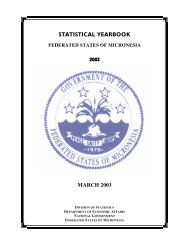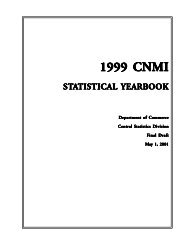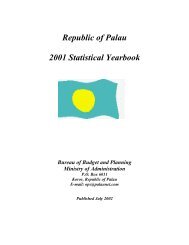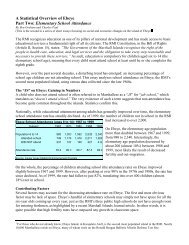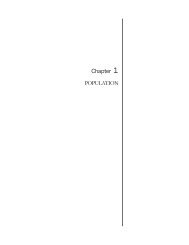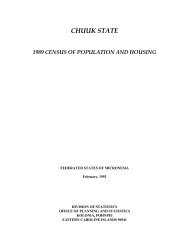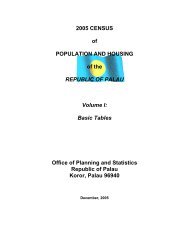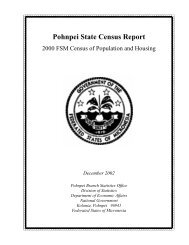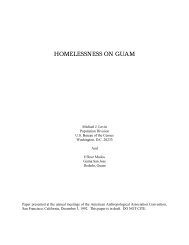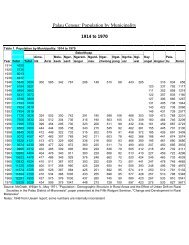Chuuk State Census Report - pacificweb.org
Chuuk State Census Report - pacificweb.org
Chuuk State Census Report - pacificweb.org
You also want an ePaper? Increase the reach of your titles
YUMPU automatically turns print PDFs into web optimized ePapers that Google loves.
2000 FSM <strong>Census</strong> of <strong>Chuuk</strong> <strong>State</strong>Executive SummaryBirthplace. Over 98 percent of the <strong>Chuuk</strong> residents in 1994 and 2000 were born in <strong>Chuuk</strong>. The proportion of <strong>Chuuk</strong>residents born outside of <strong>Chuuk</strong> decreased between 1994 and 2000, especially among the Asian-born persons. Theproportion of Asian-born persons declined by 50 percent (from about 489 persons in1994 to about 51 in 2000). Thisdecline was largely due to the dissolution of the foreign fishing venture (which mostly employed these persons) in theintercensal period.Residence 5 years before the census. Cross-classification of data on residence 5 years before the census with currentresidence showed the level and pattern of short-term migration. This kind of analysis further provided an estimation ofinter-state migration per year. Among the 2000 <strong>Chuuk</strong> residents aged 5 years and over, about 1 percent lived outside of<strong>Chuuk</strong> <strong>State</strong>d during 1995 (about 1.4 percent for the Lagoon and less than .5 percent for the Outer Islands). The resultprovided an estimated net interstate out-migration of 1.3 per 1,000 per year for the period 1994 and 2000,Additionally, it provided estimations of internal net migration rate the Lagoon (1.2 per 1,000) and the Outer Islands (-3.6 per 1,000) for the same period.Social CharacteristicsReligion. The Catholic and Protestant were the major religions in the <strong>State</strong> of <strong>Chuuk</strong>. The 1994 and 2000 censusesindicated that 53 percent of the residents of <strong>Chuuk</strong> were Catholics, 43 percent were Protestants and 4 percent were ofother religion. Majority of the municipalities on both the Lagoon and Outer Islands were Catholics.Ethnicity and Language Spoken at Home. About 94 percent of <strong>Chuuk</strong> residents were of <strong>Chuuk</strong>ese ethnicity. Languagecorresponds to ethnicity. Over 99 percent reported <strong>Chuuk</strong>ese as their commonly used language at home. About 91percent of <strong>Chuuk</strong> residents reported English as their second most commonly used language.School Enrollment. In 2000, about 56 percent of persons age 3 to 24 were enrolled in school. Among these enrolledpersons, about 5 percent were attending pre-school, 64 percent were in elementary school, 27 percent in high school,and 4 percent in college.Educational Attainment. In 2000 about 17.8 percent of among all persons 25 years old and over did not complete anylevel of schooling, compared to 34.6 percent in 1980. Also, the proportion attaining high school increased from 16.4 to34.1, and the proportion attained college increased from 5.8 percent to 13.7 percent.Economic CharacteristicsLabor Force Participation. Labor force participation was compiled based on the current economic activity (that is,economic activities during a seven day reference period). The overall labor force participation rate of persons 15 yearsand over during the week before the 2000 <strong>Census</strong> in <strong>Chuuk</strong> was about 58 percent, compared with 38 percent in 1994.The male participation rate was (67 percent) while the female was (48 percent). The unemployment rate in 2000, basedon UN classification, was over 34 percent. By region, unemployment was highest in Faichuk at about 40 percent,followed by Oksoritod with 38 percent and Northern Namoneas with 37 percent. Southern Namoneas and Mortlockshad slightly lower unemployment rates of 23 percent and 33 percent, respectively.Subsistence. Out of about 11,979 employed persons in 2000, about 7,433 persons were engaged in agricultural, fisheryor related activities. About 2,299 persons were engaged in market oriented agricultural, fishery, or related activitieswhile the remaining 5,134 persons were in pure subsistence (did subsistence for household consumption only and didnot sell).Industry and Occupation. The formal work force in <strong>Chuuk</strong> in 2000 was about 4,546 (a 15 percent decrease since1994). The number of workers in most of the industries decline, except for four industries: Gas, electricity & watersupply, Transportation & communication, Wholesale & retail trade, and Public Administration.About 36 percent of the formal work force were manages and professional workers. Technicians and associateprofessionals (about 13 percent) and service workers (about 17 percent) were also reported as major occupations.Administrative support also had a high percentage (12 percent). Skilled agricultural and fishery workers constitutedabout 1 percent of all formal workers.<strong>Chuuk</strong> Branch Statistics Office, Division of Statistics, FSM Department of Economic Affairsxxv



